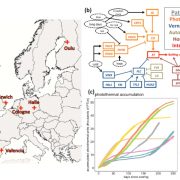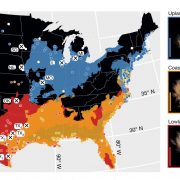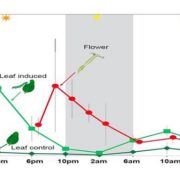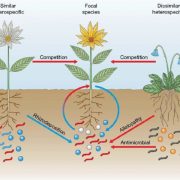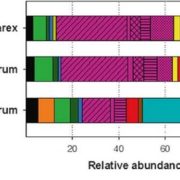A worldwide-scale relationship between leaf size and climate ($)
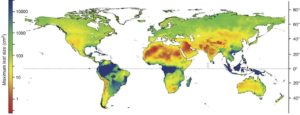 Leaf size varies by over 100,000-fold across the plant kingdom. Leaf area has a direct impact on tissue temperature and thus directly affects photosynthetic efficiency. Empirical observations by 19th century plant geographers described that larger leaves are usually restricted to plants growing in wet tropics; nevertheless environmental factors driving leaf size haven’t been studied at a global scale. This elegant study by Wright et al. provides a worldwide-scale quantification of how climatic drivers such as temperature, irradiance and moisture impact leaf size. The authors compiled leaf size datasets for more than 7,600 plant species sampled from hundreds of locations worldwide. Leaf size patterns were then compared to climatic variables. The analysis revealed that plant species harboring large leaves are usually located in hot and humid areas with high irradiance, while small-leaves-species are separated in two distinct climatic regions: hot and sunny arid regions as well as high altitude, high latitude areas. Based on these observations, the authors provide a model incorporating geographical limits to leaf size and revealing that day and night leaf-to-air temperature variation drive geographic gradients in leaf size. These data provide an important contribution towards designing better models on the consequence of climate change on vegetation. (Summary by Matthias Benoit) Science 10.1126/science.aal4760
Leaf size varies by over 100,000-fold across the plant kingdom. Leaf area has a direct impact on tissue temperature and thus directly affects photosynthetic efficiency. Empirical observations by 19th century plant geographers described that larger leaves are usually restricted to plants growing in wet tropics; nevertheless environmental factors driving leaf size haven’t been studied at a global scale. This elegant study by Wright et al. provides a worldwide-scale quantification of how climatic drivers such as temperature, irradiance and moisture impact leaf size. The authors compiled leaf size datasets for more than 7,600 plant species sampled from hundreds of locations worldwide. Leaf size patterns were then compared to climatic variables. The analysis revealed that plant species harboring large leaves are usually located in hot and humid areas with high irradiance, while small-leaves-species are separated in two distinct climatic regions: hot and sunny arid regions as well as high altitude, high latitude areas. Based on these observations, the authors provide a model incorporating geographical limits to leaf size and revealing that day and night leaf-to-air temperature variation drive geographic gradients in leaf size. These data provide an important contribution towards designing better models on the consequence of climate change on vegetation. (Summary by Matthias Benoit) Science 10.1126/science.aal4760


